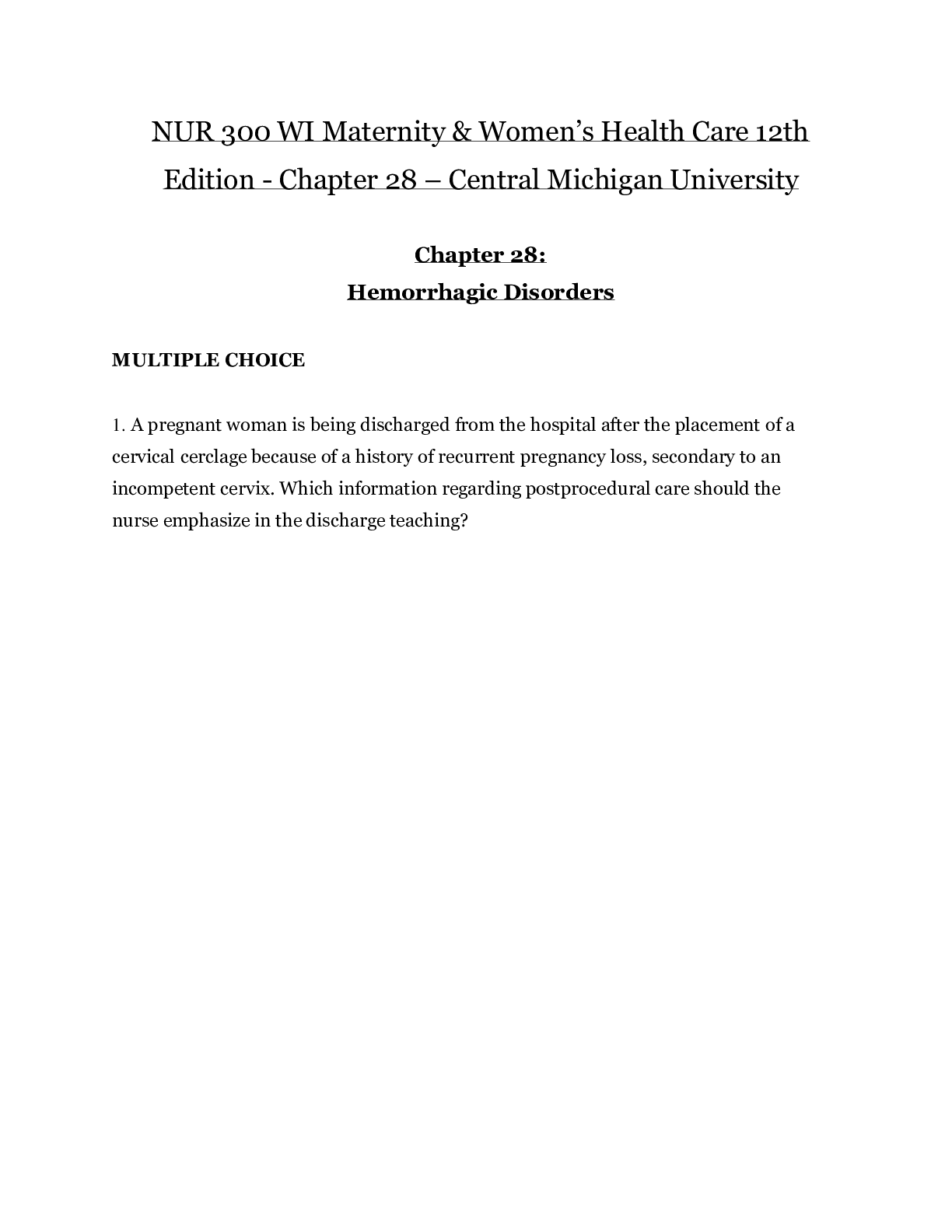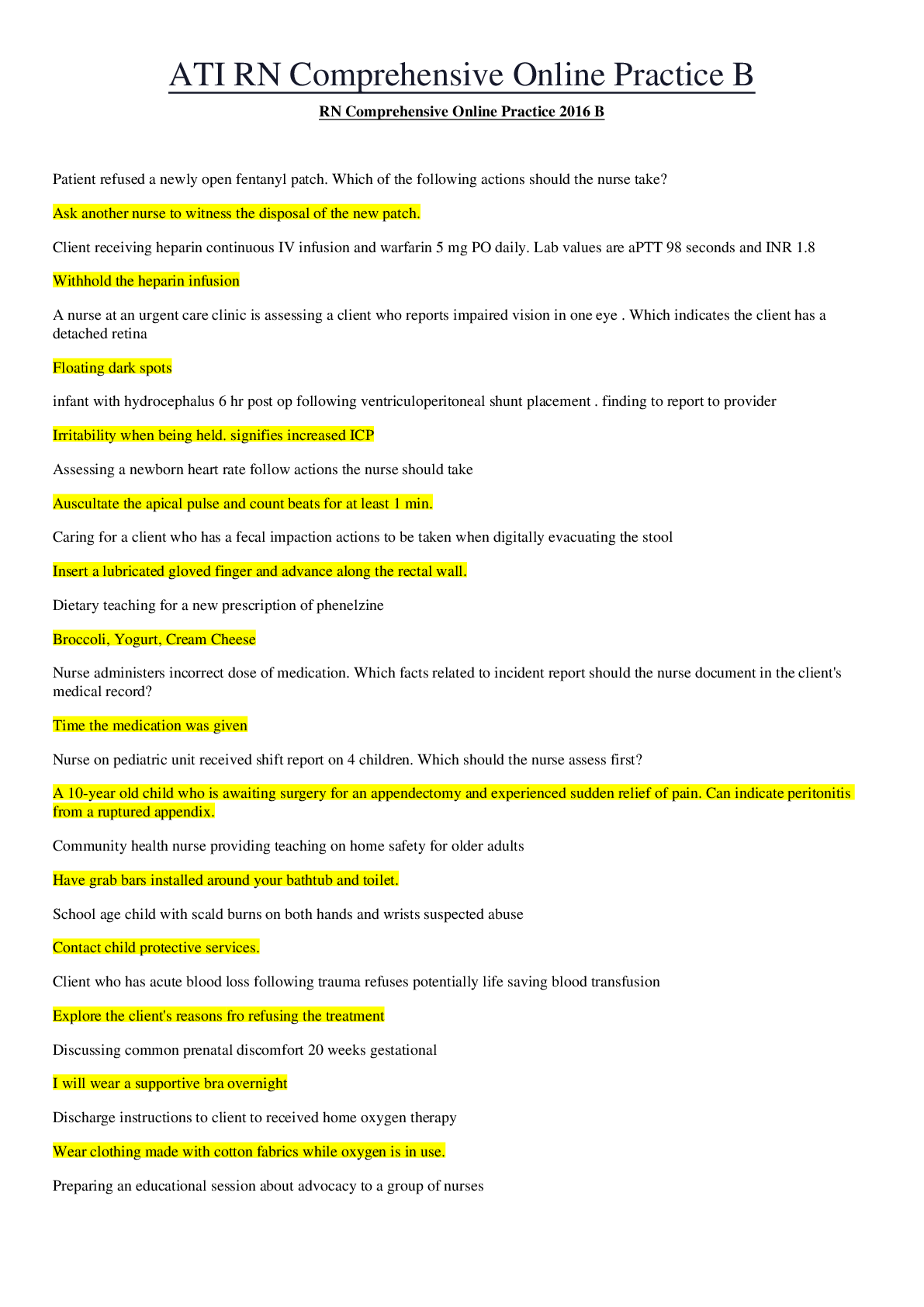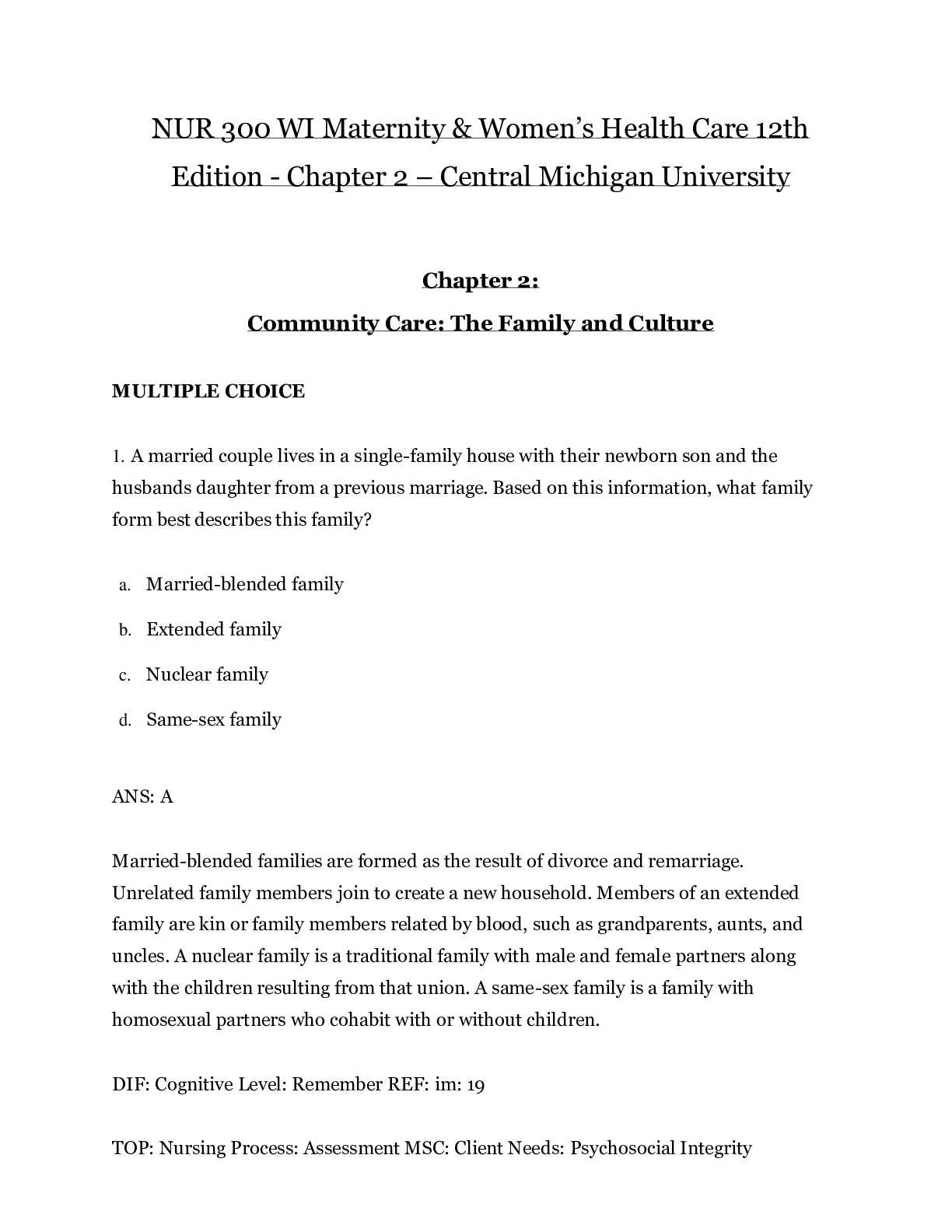*NURSING > EXAM > NUR 300 WI Maternity & Women’s Health Care 12th Edition (2019/2020) - Chapter 28 – Central Michi (All)
NUR 300 WI Maternity & Women’s Health Care 12th Edition (2019/2020) - Chapter 28 – Central Michigan University | Hemorrhagic Disorders
Document Content and Description Below
NUR 300 WI Maternity & Women’s Health Care 12th Edition - Chapter 28 – Central Michigan University Chapter 28: Hemorrhagic Disorders MULTIPLE CHOICE 1. A pregnant woman is being dischar... ged from the hospital after the placement of a cervical cerclage because of a history of recurrent pregnancy loss, secondary to an incompetent cervix. Which information regarding postprocedural care should the nurse emphasize in the discharge teaching? a. Any vaginal discharge should be immediately reported to her health care provider. b. The presence of any contractions, rupture of membranes (ROM), or severe perineal pressure should be reported. c. The client will need to make arrangements for care at home, because her activity level will be restricted. d. The client will be scheduled for a cesarean birth. Nursing care should stress the importance of monitoring for the signs and symptoms of preterm labor. Vaginal bleeding needs to be reported to her primary health care provider. Bed rest is an element of care. However, the woman may stand for periods of up to 90 minutes, which allows her the freedom to see her physician. Home uterine activity monitoring may be used to limit the womans need for visits and to monitor her status safely at home. The cerclage can be removed at 37 weeks of gestation (to prepare for a vaginal birth), or a cesarean birth can be planned. DIF: Cognitive Level: Apply REF: IM: 675 TOP: Nursing Process: Planning | Nursing Process: Implementation MSC: Client Needs: Health Promotion and Maintenance 2. A perinatal nurse is giving discharge instructions to a woman, status postsuction, and curettage secondary to a hydatidiform mole. The woman asks why she must take oral contraceptives for the next 12 months. What is the bestresponse by the nurse? a. If you get pregnant within 1 year, the chance of a successful pregnancy is very small. Therefore, if you desire a future pregnancy, it would be better for you to use the most reliable method of contraception available. b. The major risk to you after a molar pregnancy is a type of cancer that can be diagnosed only by measuring the same hormone that your body produces during pregnancy. If you were to get pregnant, then it would make the diagnosis of this cancer more difficult. c. If you can avoid a pregnancy for the next year, the chance of developing a second molar pregnancy is rare. Therefore, to improve your chance of a successful pregnancy, not getting pregnant at this time is best. d. Oral contraceptives are the only form of birth control that will prevent a recurrence of a molar pregnancy. Betahuman chorionic gonadotropin (beta-hCG) hormone levels are drawn for 1 year to ensure that the mole is completely gone. The chance of developing choriocarcinoma after the development of a hydatidiform mole is increased. Therefore, the goal is to achieve a zero human chorionic gonadotropin (hCG) level. If the woman were to become pregnant, then it may obscure the presence of the potentially carcinogenic cells. Women should be instructed to use birth control for 1 year after treatment for a hydatidiform mole. The rationale for avoiding pregnancy for 1 year is to ensure that carcinogenic cells are not present. Any contraceptive method except an intrauterine device (IUD) is acceptable. DIF: Cognitive Level: Apply REF: IM: 679 TOP: Nursing Process: Planning | Nursing Process: Implementation MSC: Client Needs: Physiologic Integrity 3. The nurse is preparing to administer methotrexate to the client. This hazardous drug is most often used for which obstetric complication? a. Complete hydatidiform mole b. Missed abortion c. Unruptured ectopic pregnancy d. Abruptio placentae Methotrexate is an effective nonsurgical treatment option for a hemodynamically stable woman whose ectopic pregnancy is unruptured and measures less than 4 cm in diameter. Methotrexate is not indicated or recommended as a treatment option for a complete hydatidiform mole, for a missed abortion, or for abruptio placentae. DIF: Cognitive Level: Apply REF: IM: 677 TOP: Nursing Process: Planning MSC: Client Needs: Physiologic Integrity 4. A 26-year-old pregnant woman, gravida 2, para 1-0-0-1, is 28 weeks pregnant when she experiences bright red, painless vaginal bleeding. On her arrival at the hospital, which diagnostic procedure will the client most likely have performed? a. Amniocentesis for fetal lung maturity b. Transvaginal ultrasound for placental location c. Contraction stress test (CST) d. Internal fetal monitoring The presence of painless bleeding should always alert the health care team to the possibility of placenta previa, which can be confirmed through ultrasonography. Amniocentesis is not performed on a woman who is experiencing bleeding. In the event of an imminent delivery, the fetus is presumed to have immature lungs at this gestational age, and the mother is given corticosteroids to aid in fetal lung maturity. A CST is not performed at a preterm gestational age. Furthermore, bleeding is a contraindication to a CST. Internal fetal monitoring is also contraindicated in the presence of bleeding. DIF: Cognitive Level: Apply REF: IM: 680 TOP: Nursing Process: Assessment MSC: Client Needs: Health Promotion and Maintenance 5. A laboring woman with no known risk factors suddenly experiences spontaneous ROM. The fluid consists of bright red blood. Her contractions are consistent with her current stage of labor. No change in uterine resting tone has occurred. The fetal heart rate (FHR) begins to decline rapidly after the ROM. The nurse should suspect the possibility of what condition? a. Placenta previa b. Vasa previa c. Severe abruptio placentae d. Disseminated intravascular coagulation (DIC) Vasa previa is the result of a velamentous insertion of the umbilical cord. The umbilical vessels are not surrounded by Wharton jelly and have no supportive tissue. The umbilical blood vessels thus are at risk for laceration at any time, but laceration occurs most frequently during ROM. The sudden appearance of bright red blood at the time of ROM and a sudden change in the FHR without other known risk factors should immediately alert the nurse to the possibility of vasa previa. The presence of placenta previa most likely would be ascertained before labor and is considered a risk factor for this pregnancy. In addition, if the woman had a placenta previa, it is unlikely that she would be allowed to pursue labor and a vaginal birth. With the presence of severe abruptio placentae, the uterine tonicity typically is tetanus (i.e., a boardlike uterus). DIC is a pathologic form of diffuse clotting that consumes large amounts of clotting factors, causing widespread external bleeding, internal bleeding, or both. DIC is always a secondary diagnosis, often associated with obstetric risk factors such as the hemolysis, elevated liver enzyme levels, and low platelet levels (HELLP) syndrome. This woman did not have any prior risk factors. DIF: Cognitive Level: Analyze REF: IM: 684 TOP: Nursing Process: Diagnosis MSC: Client Needs: Physiologic Integrity 6. A woman arrives for evaluation of signs and symptoms that include a missed period, adnexal fullness, tenderness, and dark red vaginal bleeding. On examination, the nurse notices an ecchymotic blueness around the womans umbilicus. What does this finding indicate? a. Normal integumentary changes associated with pregnancy b. Turner sign associated with appendicitis c. Cullen sign associated with a ruptured ectopic pregnancy d. Chadwick sign associated with early pregnancy Cullen sign, the blue ecchymosis observed in the umbilical area, indicates hematoperitoneum associated with an undiagnosed ruptured intraabdominal ectopic pregnancy. Linea nigra on the abdomen is the normal integumentary change associated with pregnancy and exhibits a brown pigmented, vertical line on the lower abdomen. Turner sign is ecchymosis in the flank area, often associated with pancreatitis. A Chadwick sign is a blue-purple cervix that may be seen during or around the eighth week of pregnancy. DIF: Cognitive Level: Analyze REF: IM: 676 TOP: Nursing Process: Assessment MSC: Client Needs: Physiologic Integrity 7. The nurse who elects to practice in the area of womens health must have a thorough understanding of miscarriage. Which statement regarding this condition is most accurate? a. A miscarriage is a natural pregnancy loss before labor begins. b. It occurs in fewer than 5% of all clinically recognized pregnancies. c. Careless maternal behavior, such as poor nutrition or excessive exercise, can be a factor in causing a miscarriage. d. If a miscarriage occurs before the 12th week of pregnancy, then it may be observed only as moderate discomfort and blood loss. Before the sixth week, the only evidence might be a heavy menstrual flow. After the 12th week, more severe pain, similar to that of labor, is likely. Miscarriage is a natural pregnancy loss, but it occurs, by definition, before 20 weeks of gestation, before the fetus is viable. Miscarriages occur in approximately 10% to 15% of all clinically recognized pregnancies. Miscarriages can be caused by a number of disorders or illnesses outside the mothers control or knowledge. DIF: Cognitive Level: Understand REF: IM: 670 TOP: Nursing Process: Assessment MSC: Client Needs: Physiologic Integrity - - - - - - - - - - - - - - - - - - - - - - - - - 19. What is the correct terminology for an abortion in which the fetus dies but is retained within the uterus? a. Inevitable abortion b. Missed abortion c. Incomplete abortion d. Threatened abortion Missed abortion refers to the retention of a dead fetus in the uterus. An inevitable abortion means that the cervix is dilating with the contractions. An incomplete abortion means that not all of the products of conception were expelled. With a threatened abortion, the woman has cramping and bleeding but no cervical dilation. DIF: Cognitive Level: Remember REF: IM: 670 TOP: Nursing Process: Assessment MSC: Client Needs: Physiologic Integrity 20. What condition indicates concealed hemorrhage when the client experiences abruptio placentae? a. Decrease in abdominal pain b. Bradycardia c. Hard, boardlike abdomen d. Decrease in fundal height Concealed hemorrhage occurs when the edges of the placenta do not separate. The formation of a hematoma behind the placenta and subsequent infiltration of the blood into the uterine muscle results in a very firm, boardlike abdomen. Abdominal pain may increase. The client will have shock symptoms that include tachycardia. As bleeding occurs, the fundal height increases. DIF: Cognitive Level: Analyze REF: IM: 683 TOP: Nursing Process: Assessment MSC: Client Needs: Physiologic Integrity 21. What is the highest priority nursing intervention when admitting a pregnant woman who has experienced a bleeding episode in late pregnancy? a. Assessing FHR and maternal vital signs b. Performing a venipuncture for hemoglobin and hematocrit levels c. Placing clean disposable pads to collect any drainage d. Monitoring uterine contractions Assessment of the FHR and maternal vital signs will assist the nurse in determining the degree of the blood loss and its effect on the mother and fetus. The most important assessment is to check the well-being of both the mother and the fetus. The blood levels can be obtained later. Assessing future bleeding is important; however, the top priority remains mother/fetal well-being. Monitoring uterine contractions is important but not a top priority. DIF: Cognitive Level: Apply REF: IM: 681 TOP: Nursing Process: Implementation MSC: Client Needs: Health Promotion and Maintenance 22. Which order should the nurse expect for a client admitted with a threatened abortion? a. Bed rest b. Administration of ritodrine IV c. Nothing by mouth (nil per os [NPO]) d. Narcotic analgesia every 3 hours, as needed Decreasing the womans activity level may alleviate the bleeding and allow the pregnancy to continue. Ritodrine is not the first drug of choice for tocolytic medications. Having the woman placed on NPO is unnecessary. At times, dehydration may produce contractions; therefore, hydration is important. Narcotic analgesia will not decrease the contractions and may mask the severity of the contractions. DIF: Cognitive Level: Understand REF: pp. 671-672 TOP: Nursing Process: Planning MSC: Client Needs: Health Promotion and Maintenance 23. Which finding on a prenatal visit at 10 weeks of gestation might suggest a hydatidiform mole? a. Complaint of frequent mild nausea b. Blood pressure of 120/80 mm Hg c. Fundal height measurement of 18 cm d. History of bright red spotting for 1 day, weeks ago The uterus in a hydatidiform molar pregnancy is often larger than would be expected on the basis of the duration of the pregnancy. Nausea increases in a molar pregnancy because of the increased production of hCG. A woman with a molar pregnancy may have early-onset pregnancy-induced hypertension. In the clients history, bleeding is normally described as brownish. DIF: Cognitive Level: Analyze REF: IM: 678 TOP: Nursing Process: Assessment MSC: Client Needs: Health Promotion and Maintenance 24. A 32-year-old primigravida is admitted with a diagnosis of ectopic pregnancy. Which information assists the nurse in developing the plan of care? a. Bed rest and analgesics are the recommended treatment. b. She will be unable to conceive in the future. c. A D&C will be performed to remove the products of conception. d. Hemorrhage is the primary concern. Severe bleeding occurs if the fallopian tube ruptures. The recommended treatment is to remove the pregnancy before rupture to prevent hemorrhaging. If the tube must be removed, then the womans fertility will decrease; however, she will not be infertile. A D&C is performed on the inside of the uterine cavity. The ectopic pregnancy is located within the tubes. DIF: Cognitive Level: Apply REF: IM: 676 TOP: Nursing Process: Planning MSC: Client Needs: Physiologic Integrity MULTIPLE RESPONSE 1. A client who has undergone a D&C for early pregnancy loss is likely to be discharged the same day. The nurse must ensure that her vital signs are stable, that bleeding has been controlled, and that the woman has adequately recovered from the administration of anesthesia. To promote an optimal recovery, what information should discharge teaching include? (Select all that apply.) a. Iron supplementation b. Resumption of intercourse at 6 weeks postprocedure c. Referral to a support group, if necessary d. Expectation of heavy bleeding for at least 2 weeks e. Emphasizing the need for rest , C, E The woman should be advised to consume a diet high in iron and protein. For many women, iron supplementation also is necessary. The nurse should acknowledge that the client has experienced a loss, however early. She can be taught to expect mood swings and possibly depression. Referral to a support group, clergy, or professional counseling may be necessary. Discharge teaching should emphasize the need for rest. Nothing should be placed in the vagina for 2 weeks after the procedure, including tampons and vaginal intercourse. The purpose of this recommendation is to prevent infection. Should infection occur, antibiotics may be prescribed. The client should expect a scant, dark discharge for 1 to 2 weeks. Should heavy, profuse, or bright bleeding occur, she should be instructed to contact her health care provider. DIF: Cognitive Level: Apply REF: IM: 672 TOP: Nursing Process: Implementation MSC: Client Needs: Physiologic Integrity 2. Approximately 10% to 15% of all clinically recognized pregnancies end in miscarriage. What are possible causes of early miscarriage? (Select all that apply.) a. Chromosomal abnormalities b. Infections c. Endocrine imbalance d. Systemic disorders e. Varicella , C, D, E Infections are not a common cause of early miscarriage. At least 50% of pregnancy losses result from chromosomal abnormalities. Endocrine imbalances such as hypothyroidism or diabetes are also possible causes for early pregnancy loss. Other systemic disorders that may contribute to pregnancy loss include lupus and genetic conditions. Although infections are not a common cause of early miscarriage, varicella infection in the first trimester has been associated with pregnancy loss. DIF: Cognitive Level: Remember REF: IM: 669 TOP: Nursing Process: Assessment MSC: Client Needs: Health Promotion and Maintenance 3. The reported incidence of ectopic pregnancy has steadily risen over the past 2 decades. Causes include the increase in sexually transmitted infections (STIs) accompanied by tubal infection and damage. The popularity of contraceptive devices such as the IUD has also increased the risk for ectopic pregnancy. The nurse suspects that a client has early signs of ectopic pregnancy. The nurse should be observing the client for which signs or symptoms? (Select all that apply.) a. Pelvic pain b. Abdominal pain c. Unanticipated heavy bleeding d. Vaginal spotting or light bleeding e. Missed period , B, D, E A missed period or spotting can be easily mistaken by the client as an early sign of pregnancy. More subtle signs depend on exactly where the implantation occurs. The nurse must be thorough in her assessment because pain is not a normal symptom of early pregnancy. As the fallopian tube tears open and the embryo is expelled, the client often exhibits severe pain accompanied by intraabdominal hemorrhage, which may progress to hypovolemic shock with minimal or even no external bleeding. In approximately one half of women, shoulder and neck pain results from irritation of the diaphragm from the hemorrhage. [Show More]
Last updated: 2 years ago
Preview 1 out of 34 pages

Buy this document to get the full access instantly
Instant Download Access after purchase
Buy NowInstant download
We Accept:

Reviews( 0 )
$12.50
Can't find what you want? Try our AI powered Search
Document information
Connected school, study & course
About the document
Uploaded On
Jun 29, 2020
Number of pages
34
Written in
Additional information
This document has been written for:
Uploaded
Jun 29, 2020
Downloads
0
Views
71








 – University of the People.png)

















